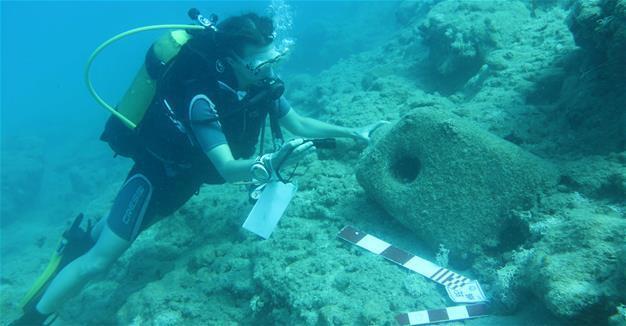Ancient wreckages discovered on southern coasts in Mersin
ANTALYA – DHA
 Underwater research on the coast of the southern province of Mersin have discovered 18 shipwrecks on a coastline of 100 kilometers. The wreckages date back between 1,000 and 2,700 years.
Underwater research on the coast of the southern province of Mersin have discovered 18 shipwrecks on a coastline of 100 kilometers. The wreckages date back between 1,000 and 2,700 years.The Director of Underwater Projects Assistant Professor Hakan Öniz said that archaeological underwater research has been carried out on the coasts of Mersin since 2015. “With a 30-person team of underwater archaeologists, we carried out productive work on the coasts of Mersin in 2017,” he said.
“We have determined 18 ancient shipwrecks on a coast of 100 meters in Mersin’s Aydıncık, Gülnar and Silifke districts. One of the ships was carrying plates and 16 ships were carrying amphorae. The other wreckage was probably a war ship or was returning to the harbor after unloading its cargo. The amphorae reveal international trade. Almost half of the amphorae were produced in the amphora ateliers in the east of Antalya and on the Mersin coastline. We estimate they contained wine or olive oil. These products show us agriculture and trade that developed in the region especially after the second century A.D,” Öniz said. He was also very surprised with the results they reached during the works.
He mentioned they discovered 14 wreckages during their work in 2015 and 2016.
“Two to three wreckages had been found during previous works before ours. But this year we focused on the underwater research for 20 days. It is very important that 18 wreckages were found on a coastline of 100 kilometers in 20 days. These wreckages are from the Classical, Roman and Byzantine era. They are 1,000-2,700 years old. The reason why they were found within a short time is that the Selçuk 1 research ship uses the latest technology. We have sonar tools and underwater robots in three different types. We have technology to show underwater from the surface. By using these tools, we can determine the seabed and sometimes even below the seabed,” Öniz said.
Maritime was common 3,500 years ago
Öniz said another result that made them excited was the discovery of 24 stone anchors, ruins of 11 anchors from the Iron Age and 17 anchors from the Roman and Byzantines eras.
“Especially, the abundance of stone anchors from the Bronze Age reveals that maritime was common and comprehensive on the coasts of Mersin 3,000-3,500 years ago. It means people used the sea both internationally and regionally,” he said.
He also said ships begin to adapt to another environment as soon as they sink.
“Normally, we cannot find ship wreckages with their wood because the sea creatures in the bottom of the sea destroy organic materials. The inorganic materials become adapted to the conditions in the bottom of the sea. As soon as you remove them from the water, the process of protection and restoration starts, which is expensive. Each wreckage does not need to be removed from the sea and displayed at a museum.
Sometimes you have to protect them in their own place. Now our plan is to protect them without removal. But if an excavation of the wreckages is considered necessary in the future by the Culture and Tourism Ministry, they will be removed and delivered to the museums in the region,” said Öniz.
















